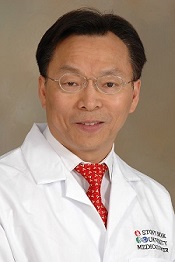Dr. Jerome Zhengrong Liang: A Pioneer in Virtual Colonoscopy
From a young age, Professor Jerome Zhengrong Liang was captivated by the mysteries
of the universe. 
His curiosity extended to the human biological system, drawing parallels between its intricate workings and the vast, dynamic balance of the cosmos.
“At the fundamental level, we cannot measure precisely what constitutes the universe or its true scale,” observes Professor Liang. “Yet, we are compelled to explore why life begins at the molecular level within this universal architecture.”
To probe these profound questions, Professor Liang turned to his instrument of choice: medical imaging.
Professor Liang, a renowned scientist at Stony Brook Medicine, is a trailblazer in medical imaging, with a particular focus on revolutionizing cancer detection. His groundbreaking work in early cancer detection through non-invasive, safe, and cost-effective imaging techniques has propelled advancements in the early cancer diagnosis, notably in the prevention and detection of colorectal cancer.
One of Professor Liang’s most significant contributions was the development of virtual colonoscopy - a non-invasive alternative to traditional colonoscopy. This revolutionary technique allows for the screening and characterization of colorectal polyps, greatly enhancing the early detection of colorectal cancer.
"Many patients feel apprehension about undergoing a traditional colonoscopy,” Professor Liang explains. “I was determined to develop a virtual protocol, through extensive research, that my colleagues could adopt to reduce this patient anxiety.”
Traditional colonoscopy, an invasive procedure requiring sedation or anesthesia, can cause discomfort and carries certain risks for patients. Additionally, the limited visualization capabilities of traditional colonoscopy make it difficult to distinguish between benign and high-risk polyps, resulting in unnecessary procedures. Professor Liang recognized the need for a less invasive, more patient-friendly approach to colonoscopy.
The first step in developing a virtual alternative was to adapt and develop a medical imaging modality tailored to the task. Professor Liang constructed an abdominal model containing a looped colon model embedded with several polyp models. Using a low dose computed tomography (CT) imaging protocol, the abdominal phantom was scanned, and the resulting images clearly displayed the polyps.
However, water inside the colon model can obscure the polyps, mimicking real-life scenarios where fluid in the patient’s colon might hinder polyp visualization. To address this, Professor Liang devised a protocol in which patients consumed oral contrast before going undergoing a virtual colonoscopy which would enhance the image contrast between colonic material, the colon wall, and polyps. He further developed AI computer algorithms to virtually remove the contrasted colonic materials, further ensuring clear visualization.
In addition to detecting polyps by visualizing abnormalities in the virtual colon’s lining, CT colonography (CTC) also provides volumetric data to aid in characterization of these abnormalities, offering a more comprehensive diagnostic tool.
Professor Liang further advanced the paradigm of CTC from detection only to also include diagnosis by adding AI computer algorithms to perform both CTC screening for colorectal polyps and diagnosis of the screening-detected polyps to identify the risk polyps for therapeutic removal, leading to a non-invasive, safe and cost-effective imaging approach toward prevention of colorectal cancer.
“Initial results using X-ray, magnetic resonance and ultrasound to non-invasively map the biological system produced strikingly detailed images of the in vivo anatomy,” explains Professor Liang. He emphasizes that the integration of fundamental scientific discoveries with advanced engineering strategies achieves the following tasks of: visualizing non- or minimally invasively way in vivo biological systems at molecule, cell, tissue, and organ levels; mimicking the way of physicists’ viewing the universe makeup architecture; quantifying the morphological and functional changes of the biological systems leading to new discoveries and diagnosis of abnormalities; and predicting the future courses of the biological systems towards the management of a health biological system.
Currently, Professor Liang has been leading a team as the principal investigator of several NIH projects totaling over $7M in grants to develop and evaluate the key technologies of CTC, and to detect colorectal polyps and characterize the detections for optimal management. This research has led to patent royalty income of over $9M and has generated great interest in cancer imaging worldwide.
This groundbreaking work has revolutionized medical imaging by seamlessly integrating advanced imaging technologies, in vivo tissue biology, and AI-driven algorithms. Professor Liang’s research in virtual colonoscopy has enhanced the accuracy and efficiency of colorectal screening, offering a less invasive, more patient friendly alternative to traditional colonoscopy. This innovation has paved the way for improved patient outcomes and greater accessibility to early detection methods.
